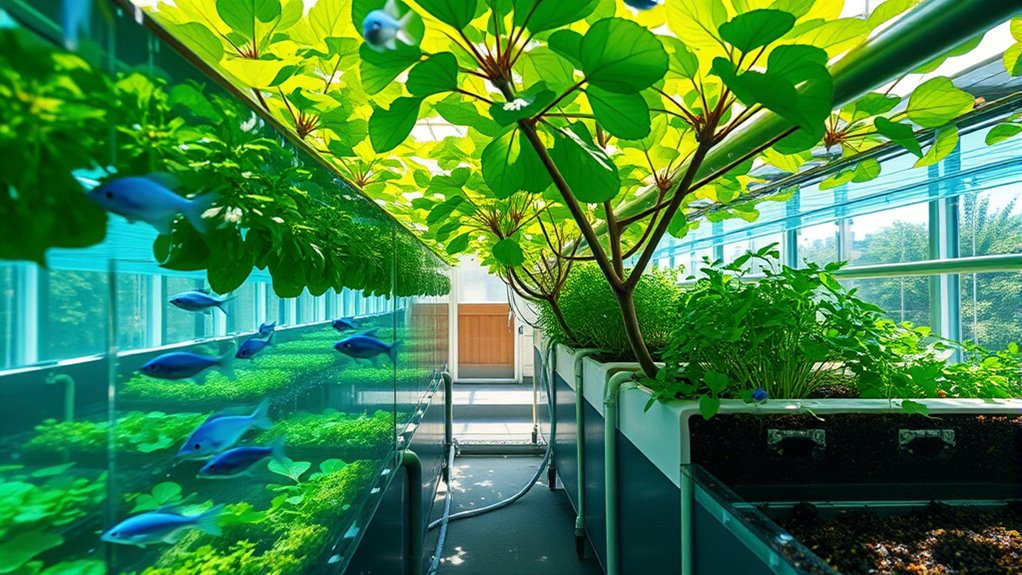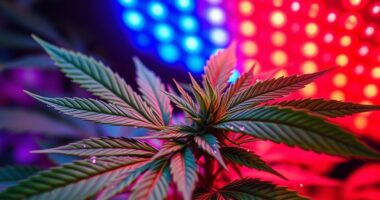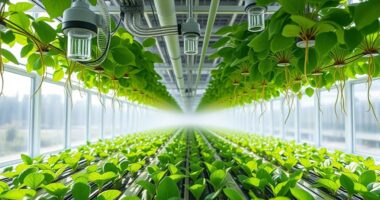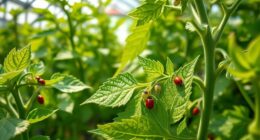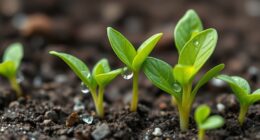Aquaponics combines fish farming and plant growth in your greenhouse, creating a sustainable, eco-friendly system. Fish waste provides natural nutrients for plants, while plants filter and clean the water. To succeed, choose adaptable fish like tilapia and hardy plants such as lettuce or herbs. Proper setup involves monitoring water quality, managing algae, and ensuring good circulation. If you want to discover how to build and maintain a thriving aquaponic system, keep exploring these key steps.
Key Takeaways
- Aquaponics combines fish farming and hydroponic plant growth in a sustainable, symbiotic system that conserves water and eliminates chemical fertilizers.
- Proper system design involves selecting suitable fish and plants, optimizing layout, light, airflow, and climate for healthy growth.
- Regularly monitor water quality parameters like pH, ammonia, and nitrite to maintain a stable environment for fish and plants.
- Use shading, cover crops, and proper circulation to control algae growth and prevent water stagnation, ensuring system health.
- Select adaptable fish species like tilapia and leafy greens such as lettuce to maximize system productivity and balance.
Understanding the Basics of Aquaponics
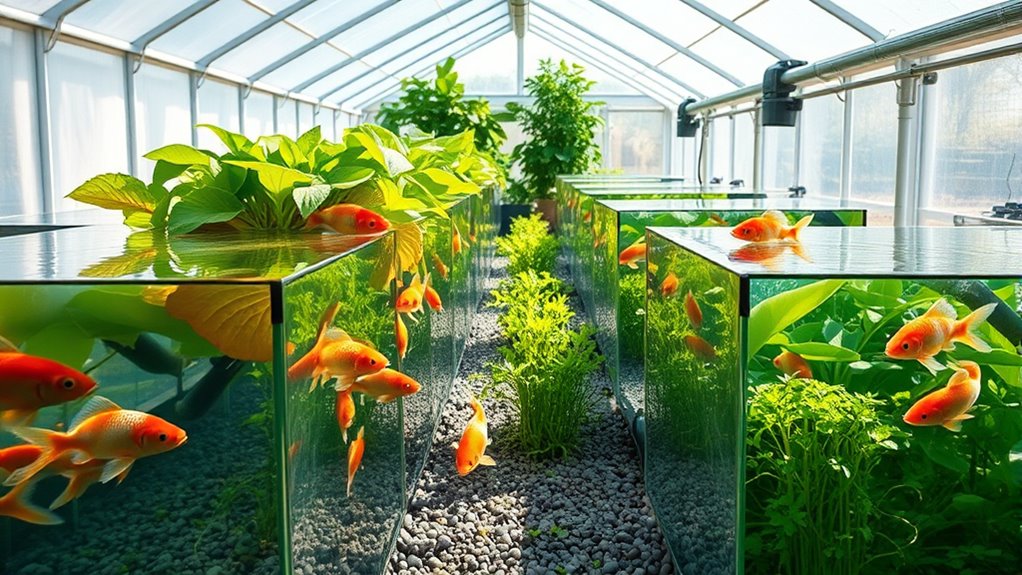
Aquaponics is a sustainable farming method that combines fish farming (aquaculture) with growing plants in water (hydroponics). Its history dates back thousands of years, with ancient civilizations like the Aztecs practicing similar techniques. Modern aquaponics emerged in the 20th century, gaining popularity for its eco-friendly nature. You should know that the ecological impact of aquaponics is significant, as it reduces water use and eliminates the need for chemical fertilizers. This system creates a balanced environment where fish waste provides nutrients for plants, and plants filter the water for fish. By understanding these basics, you’ll see how aquaponics offers an innovative, environmentally conscious way to grow food efficiently and sustainably. Ecological impact of aquaponics underscores its importance as a sustainable farming technique.
Designing Your Greenhouse Aquaponic System
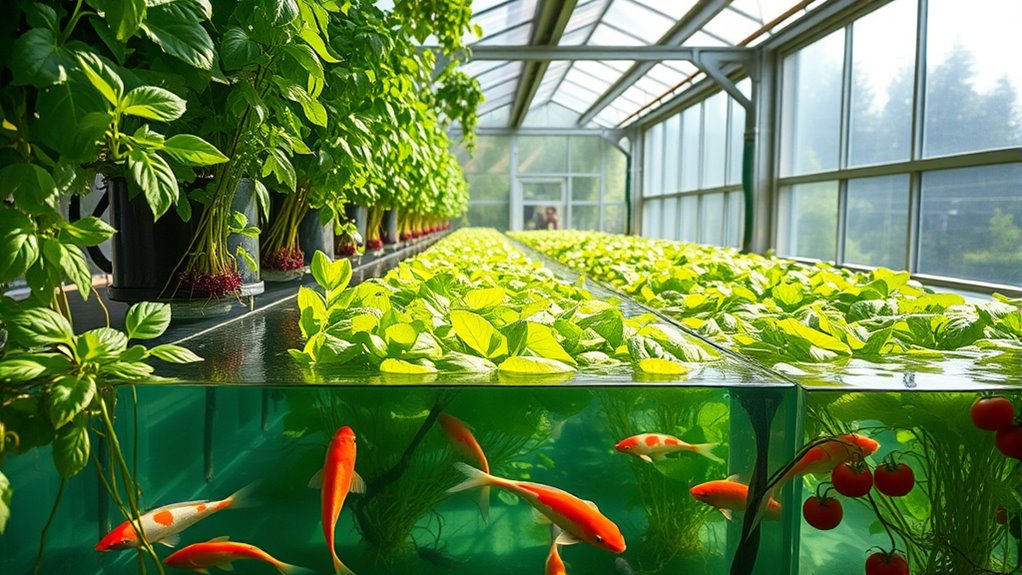
Designing a greenhouse aquaponic system requires careful planning to create an ideal environment for both fish and plants. You’ll want to contemplate aquaponic aesthetics, ensuring your setup is both functional and visually appealing, which can motivate ongoing care. Incorporate sustainable design principles to enhance ecological balance and reduce resource use. Additionally, selecting appropriate material choices can improve durability and system efficiency over time. Considering water quality management is also essential to maintain healthy conditions for fish and plants. Think about the layout, light exposure, and airflow to optimize plant growth and fish health. Incorporate elements inspired by historical aquaponics systems, which relied on simple, natural designs that balanced ecosystems. Modern design integrates these principles with innovative materials and techniques to improve efficiency and appearance. Your goal is to create a harmonious environment where water cycles seamlessly support plant and fish needs, while also reflecting a pleasing, sustainable aesthetic. Exploring remote hackathons can also inspire innovative solutions and new ideas for system design and technology integration.
Proper planning now will lead to a thriving, balanced aquaponic system.
Choosing Fish and Plants for Your Setup

Selecting the right fish and plants is essential for a successful aquaponic system because their compatibility determines the overall health and productivity. When choosing fish species, consider species like tilapia, trout, or catfish, which adapt well to controlled environments and breed easily. For plant varieties, leafy greens such as lettuce and basil thrive in aquaponic setups, along with herbs and certain vegetables. Make sure the fish you select can tolerate your water temperature and pH levels, and that the plants you choose can handle the nutrient concentrations your system provides. Balancing fish and plant choices ensures a harmonious environment where both can flourish. Proper selection minimizes disease risks and boosts crop yield, making your aquaponic system more efficient and sustainable. Additionally, understanding support hours and operational schedules for equipment and systems can help maintain optimal conditions and prevent disruptions in your setup. Maintaining awareness of privacy and cookie policies can also enhance your experience by informing you about data management practices related to your online activity.
Setting Up and Maintaining the System
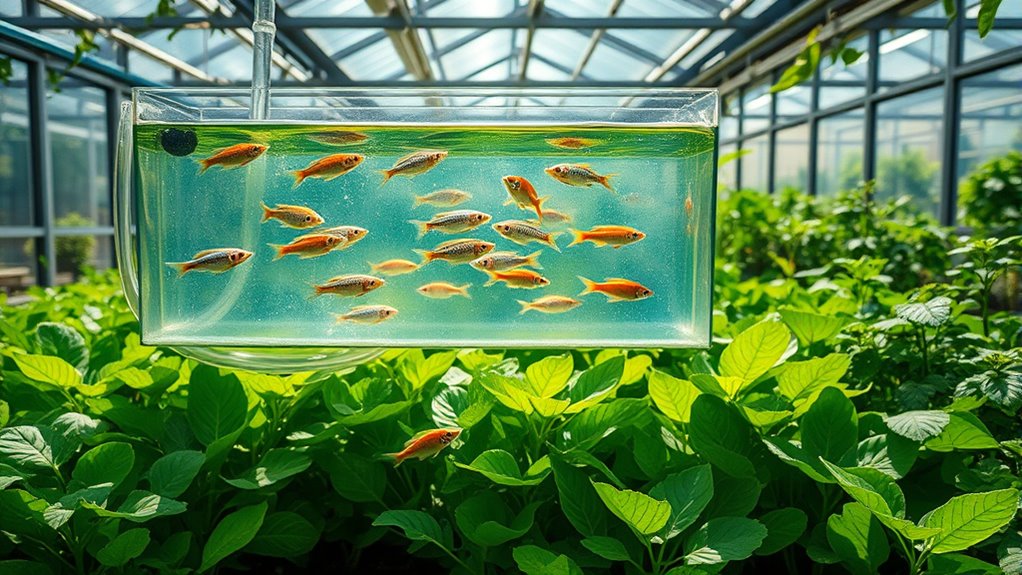
To set up your aquaponics system effectively, you need to choose the right equipment that fits your space and goals. You’ll also want to regularly monitor water quality to keep fish and plants healthy. Incorporating proper filtration methods ensures optimal water conditions for both aquatic life and plants. Using vetted products can help guarantee the safety and effectiveness of your system components. Managing the system’s balance guarantees everything runs smoothly and avoids problems down the line. Additionally, understanding inflation protection can help you plan for long-term financial stability related to your gardening investments. Considering regular maintenance routines can prevent issues and extend the lifespan of your system components.
Selecting Suitable Equipment
Choosing the right equipment is essential for guaranteeing your aquaponics system runs smoothly and efficiently. Start by selecting high-quality aquaponics equipment that matches your system’s size and needs. Investing in appropriate lighting can significantly enhance plant growth, especially in environments with limited natural sunlight. Proper lighting not only boosts photosynthesis but also helps regulate plant and fish health. Additionally, selecting equipment with energy-efficient features can reduce operational costs and promote sustainability for your system. Invest in reliable pumps, filters, and grow beds designed for aquaponics to ensure proper water circulation and filtration. Incorporate greenhouse technology like climate control systems and lighting to optimize plant growth and fish health. Using equipment with proven performance metrics can help you assess efficiency and longevity, ensuring your system remains productive. Consider durable materials that resist corrosion and wear, especially if your system is outdoors or in a humid environment. Properly chosen equipment minimizes breakdowns and maintenance, saving you time and money in the long run. Selecting equipment with high durability standards is crucial for outdoor aquaponics setups exposed to varying weather conditions. Additionally, understanding vacuum cleaner performance metrics can help you select maintenance tools that effectively keep your system clean and functioning optimally.
Monitoring Water Quality
How can you guarantee your aquaponics system remains healthy and productive? Regular water testing is essential. You need to monitor key parameters like ammonia, nitrite, nitrate, and pH levels to ensure ideal conditions. pH regulation is crucial because unstable pH can stress fish and hinder plant growth. Use test kits frequently, especially when setting up or adjusting your system. Keep the water within the perfect pH range of 6.8 to 7.2. Here’s a quick reference:
| Parameter | Ideal Range |
|---|---|
| pH | 6.8 – 7.2 |
| Ammonia | 0 ppm |
| Nitrite | 0 ppm |
| Nitrate | < 50 ppm |
| Water Temperature | 65–75°F (18–24°C) |
Consistent monitoring and regulation help maintain system stability and health. Additionally, understanding how water quality parameters influence plant and fish health is vital for successful aquaponics. Properly managing pH levels can prevent stress and disease in your aquatic life, ensuring a thriving ecosystem. Maintaining optimal water conditions also involves keeping an eye on ammonia and nitrite levels, as imbalances can quickly harm your system. Regularly testing these parameters allows for timely adjustments, which are key to aquaponics success.
Managing System Balance
Establishing and maintaining a balanced aquaponics system requires careful setup and ongoing adjustments. You need to monitor and control factors like pH balancing to guarantee fish and plants thrive. Regularly check water parameters, adjusting pH levels as needed to prevent stress or disease.
Algae control is also essential; excess algae can disrupt nutrient flow and oxygen levels. To manage system balance effectively, consider these steps:
- Maintain consistent water circulation to prevent stagnation.
- Use shading or cover crops to limit algae growth.
- Regularly test and adjust pH to stay within ideal ranges.
- Introduce beneficial bacteria to support nutrient cycling.
Troubleshooting Common Challenges
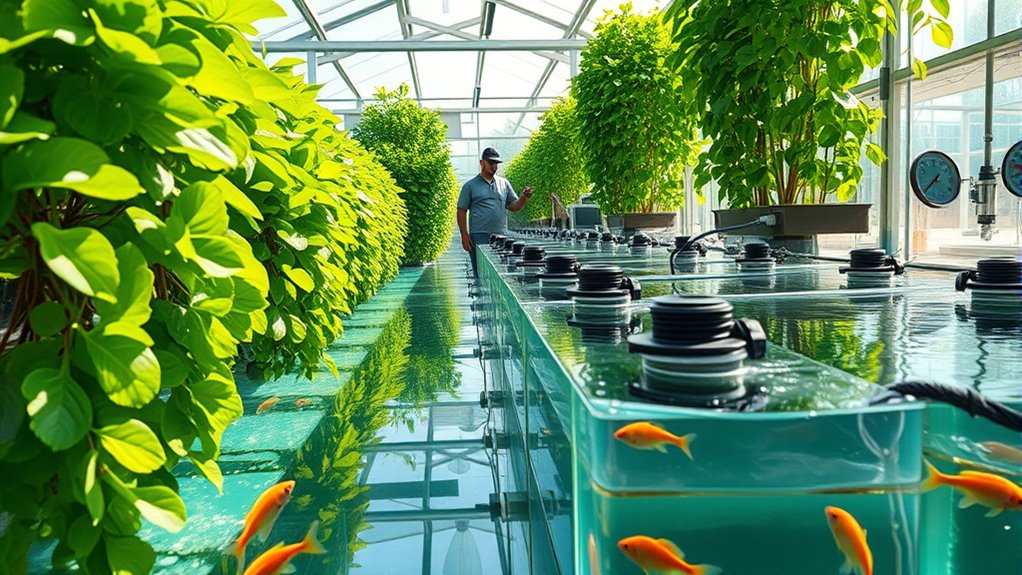
Even with careful planning, aquaponics systems can encounter common challenges that disrupt balance and productivity. One frequent issue is pH fluctuation, which can harm fish and impede nutrient uptake. Regularly test your water and make small adjustments to keep pH stable.
Another common problem is algae overgrowth, often caused by excess light and nutrients. Algae can clog filters and compete with plants for nutrients, reducing system efficiency. To prevent this, control light exposure and avoid overfeeding your fish.
Ensuring proper water circulation and maintaining consistent feeding routines also help minimize these issues. Addressing pH fluctuation and algae overgrowth early prevents larger problems, keeps your system healthy, and supports the thriving fish and plant life you’re working to cultivate.
Benefits of Aquaponics for Sustainable Gardening

Aquaponics offers a sustainable approach to gardening by combining fish cultivation with plant growth in a closed-loop system. This method enhances aquaponics efficiency, reducing water use and fertilizer needs while producing healthy crops and fish.
The environmental impact is minimal since it recycles nutrients and conserves resources. By integrating fish and plants, you create a balanced ecosystem that minimizes waste and energy consumption.
Additionally, aquaponics promotes local food production, lowering transportation emissions. It also allows you to grow a variety of crops year-round in controlled conditions.
This system supports eco-friendly gardening practices and reduces your carbon footprint. Embracing aquaponics helps you contribute to a more sustainable future while enjoying fresh, homegrown produce.
Frequently Asked Questions
What Are the Initial Costs of Starting an Aquaponics System?
When considering your initial costs for starting an aquaponics system, expect a system investment that varies based on size and complexity. You’ll need to budget for tanks, grow beds, pumps, plumbing, and fish and plant supplies.
Small setups can start around a few hundred dollars, while larger, more advanced systems could cost several thousand.
Keep in mind, initial costs are an investment in sustainable food production and long-term savings.
How Much Space Is Needed for a Small-Scale Setup?
Imagine a cozy corner in your greenhouse, where lush plants and shimmering fish thrive side by side. For a small-scale setup, you’ll need about 4 to 10 square feet of grow space requirements, depending on your plans.
Equipment needs include a fish tank, grow beds, and plumbing. This compact space lets you enjoy fresh produce and fish without overwhelming your greenhouse, making it an achievable and rewarding project.
Can Aquaponics Be Used Indoors Year-Round?
Yes, you can use aquaponics indoors year-round if you provide proper indoor lighting and humidity control. You’ll need sufficient grow lights to mimic sunlight and maintain plant growth during darker months. Controlling humidity prevents mold and keeps fish healthy. With the right setup, you can enjoy fresh produce and fish anytime, regardless of outside weather, making indoor aquaponics a sustainable and efficient option for year-round growing.
What Are the Best Water Quality Parameters for Fish Health?
Wondering what water quality parameters keep your fish healthy? You should regularly perform water testing to monitor key factors like ammonia, nitrites, nitrates, and temperature.
pH balancing is vital, aiming for a stable range of 6.8 to 7.2, ensuring ideal conditions.
Consistent checking and adjusting these parameters help prevent stress and disease, promoting a thriving aquatic environment where your fish and plants flourish together.
How Do I Prevent Pest Infestations in the System?
To prevent pest infestations, focus on effective pest management strategies. Use biological controls like beneficial insects to naturally reduce pests without chemicals.
Regularly inspect your plants and fish system for early signs of pests, and maintain cleanliness to deter infestations.
Introduce natural predators such as ladybugs or predatory mites, and avoid overusing pesticides that can harm your fish and plants.
This integrated approach keeps your system healthy and pest-free.
Conclusion
Imagine transforming your greenhouse into a self-sustaining ecosystem. Many believe aquaponics is just a trend, but it actually dates back thousands of years. By integrating fish and plants, you create a natural cycle that’s both efficient and eco-friendly. With proper setup and care, you can enjoy fresh produce and healthy fish while reducing waste. So, why not explore this ancient yet innovative method? Your sustainable gardening journey starts here—prove that nature’s balance really works.
